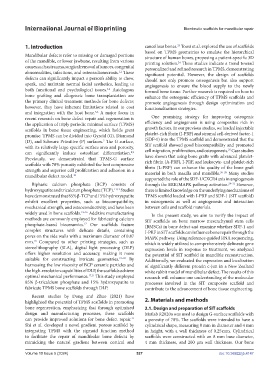Page 535 - IJB-10-5
P. 535
International Journal of Bioprinting Biomimetic scaffolds for mandibular repair
1. Introduction cancellous bones. Toosi et al. explored the use of scaffolds
23
based on TPMS geometries to emulate the hierarchical
Mandibular defects refer to missing or damaged portions structure of human bones, proposing a patient-specific 3D
of the mandible, or lower jawbone, resulting from various printing solution. These studies indicate a trend toward
24
causes such as trauma, surgical removal of tumors, congenital personalized and refined research in TPMS, demonstrating
abnormalities, infections, and osteoradionecrosis. These significant potential. However, the design of scaffolds
1,2
defects can significantly impact a person’s ability to chew, should not only promote osteogenesis but also support
speak, and maintain normal facial aesthetics, leading to angiogenesis to ensure the blood supply to the newly
both functional and psychological issues. Autologous formed bone tissue. Further research is required on how to
3,4
bone grafting and allogeneic bone transplantation are enhance the osteogenic efficiency of TPMS scaffolds and
the primary clinical treatment methods for bone defects; promote angiogenesis through design optimization and
however, they have inherent limitations related to cost functionalization strategies.
and integration with the host bone. A major focus in
5,6
recent research on bone defect repair and regeneration is One promising strategy for improving osteogenic
the application of triply periodic minimal surface (TPMS) efficiency and angiogenesis is using composites rich in
scaffolds in bone tissue engineering, which holds great growth factors. In our previous studies, we loaded injectable
promise. TPMS can be divided into Gyroid (G), Diamond platelet-rich fibrin (I-PRF) and stromal cell-derived factor-1
(D), and Schwarz Primitive (P) surfaces. The G surface, (SDF-1) into the TPMS scaffold and demonstrated that the
7
with its relatively large specific surface area and porosity, SIT scaffold showed good biocompatibility and promoted
25
can significantly induce osteoblast differentiation. cell migration, proliferation, and osteogenesis. Case studies
8,9
Previously, we demonstrated that TPMS-G surface have shown that using bone grafts with advanced platelet-
rich fibrin (A-PRF), I-PRF, and leukocyte- and platelet-rich
scaffolds with 70% porosity exhibited the best compressive fibrin (L-PRF) can enhance the quality of the bone graft
strength and superior cell proliferation and adhesion in a material in both maxilla and mandible. 26–28 Many studies
mandibular defect model. 10
supported the role of the SDF-1/CXCR4 axis in angiogenesis
Biphasic calcium phosphate (BCP) consists of through the ERK/MAPK pathway activation. 29–31 However,
hydroxyapatite and tricalcium phosphate (TCP). 11,12 Studies there is limited knowledge on the underlying mechanisms of
have demonstrated that 85% β-TCP and 15% hydroxyapatite TPMS scaffold loaded with I-PRF and SDF-1 (SIT scaffold)
exhibit excellent properties, such as biocompatibility, in osteogenesis as well as angiogenesis and interaction
mechanical strength, and osteoconductivity, and have been between cells and scaffold materials.
widely used in bone scaffolds. 13–16 Additive manufacturing In the present study, we aim to verify the impact of
methods are commonly employed for fabricating calcium SIT scaffolds on bone marrow mesenchymal stem cells
17
phosphate-based bioceramics. Our scaffolds feature (BMSCs) in bone defect and examine whether SDF-1 and
complex structures with delicate details, containing I-PRF in SIT scaffolds can influence bone repair through the
pores on the side walls with a maximum diameter of 0.87 MAPK pathway. Using reference-guided RNA sequencing,
mm. Compared to other printing strategies, such as which is widely utilized to comprehensively delineate gene
10
stereolithography (SLA), digital light processing (DLP) expression levels in response to treatment, we analyzed
offers higher resolution and accuracy, making it more the potential of SIT scaffold in mandible reconstruction.
suitable for constructing intricate geometries. 18–20 By Additionally, we evaluated the expression and localization
harnessing the low viscosity of BCP ceramic particles and of significantly different protein c-Jun in a New Zealand
the high-resolution capabilities of DLP, the scaffolds achieve white rabbit model of mandibular defect. The results of this
optimal mechanical performance. 17,21 This study employed research will enhance our understanding of the molecular
85% β-tricalcium phosphate and 15% hydroxyapatite to processes involved in the SIT composite scaffold and
fabricate TPMS bone scaffolds through DLP. contribute to the advancement of bone tissue engineering.
Recent studies by Dong and Zhao (2021) have
highlighted the potential of TPMS scaffolds in promoting 2. Materials and methods
bone regeneration, emphasizing that through optimized 2.1. Design and preparation of SIT scaffolds
design and manufacturing processes, these scaffolds Matlab R2020a was used to design G-surface scaffolds with
can provide improved solutions for bone defect repair. a porosity of 70%. The scaffolds were intended to have a
22
Shi et al. developed a novel gradient porous scaffold by cylindrical shape, measuring 8 mm in diameter and 4 mm
integrating TPMS with the sigmoid function method in height, with a wall thickness of 0.25 mm. Cylindrical
to facilitate the repair of mandibular bone defects by scaffolds were constructed with an 8 mm base diameter,
mimicking the natural gradient between cortical and 4 mm thickness, and 200 µm wall thickness. Our bone
Volume 10 Issue 5 (2024) 527 doi: 10.36922/ijb.4147

